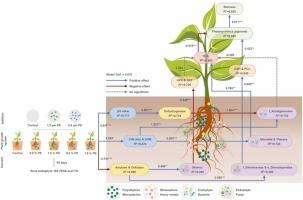Potential impacts of polyethylene microplastics and heavy metals on Bidens pilosa L. growth: Shifts in root-associated endophyte microbial communities
IF 12.2
1区 环境科学与生态学
Q1 ENGINEERING, ENVIRONMENTAL
引用次数: 0
Abstract
This study investigates the impact of polyethylene (PE) microplastics of varying particle sizes and concentrations on the growth of Bidens pilosa L. and its root-associated microbial communities in cadmium (Cd) and lead (Pb) co-contaminated soil. PE microplastics had a significant impact on plant growth. Notably, at the P05-10 level, root length, root weight, and total biomass exhibited the greatest reductions by 48.9%, 44.1%, and 45.2%, respectively. Furthermore, PE microplastics reduced photosynthetic pigment levels and promoted the accumulation of reactive oxygen species, as indicated by a 264.8% and 57.2% increase in H2O2 content in roots and leaves. High-throughput sequencing revealed substantial alterations in the composition of bacterial and fungal communities, with stress-resilient taxa such as Actinobacteria, Verrucomicrobiota, and Rhizophagus exhibiting increased relative abundance. Correlation analyses indicated that variations in soil pH and enzymatic activity influenced microbial community structure, which in turn affected plant physiological responses. Functional predictions using PICRUSt2 and BugBase suggested enhanced oxidative stress tolerance, increased secondary metabolite biosynthesis, and a higher prevalence of stress-resistant phenotypes under conditions of elevated PE concentrations and smaller particle sizes. Overall, this study provides novel insights into the potential effects of microplastics on Bidens pilosa L., particularly in its role as a hyperaccumulator, highlighting its capacity for heavy metal uptake under microplastic exposure.

本研究调查了不同粒径和浓度的聚乙烯(PE)微塑料对镉(Cd)和铅(Pb)共污染土壤中Bidens pilosa L.的生长及其根相关微生物群落的影响。聚乙烯微塑料对植物生长有显著影响。值得注意的是,在 P05-10 水平上,根长、根重和总生物量的减少幅度最大,分别为 48.9%、44.1% 和 45.2%。此外,聚乙烯微塑料还降低了光合色素水平,促进了活性氧的积累,根和叶中的 H2O2 含量分别增加了 264.8% 和 57.2%。高通量测序显示,细菌和真菌群落的组成发生了重大变化,放线菌、蛭藻微生物群和根瘤菌等抗压类群的相对丰度有所提高。相关分析表明,土壤 pH 值和酶活性的变化会影响微生物群落结构,进而影响植物的生理反应。利用 PICRUSt2 和 BugBase 进行的功能预测表明,在 PE 浓度升高和颗粒尺寸变小的条件下,氧化胁迫耐受性增强,次生代谢物生物合成增加,抗胁迫表型更为普遍。总之,本研究就微塑料对 Bidens pilosa L. 的潜在影响提供了新的见解,特别是在其作为高积累者的作用方面,突出了其在微塑料暴露下吸收重金属的能力。
本文章由计算机程序翻译,如有差异,请以英文原文为准。
求助全文
约1分钟内获得全文
求助全文
来源期刊

Journal of Hazardous Materials
工程技术-工程:环境
CiteScore
25.40
自引率
5.90%
发文量
3059
审稿时长
58 days
期刊介绍:
The Journal of Hazardous Materials serves as a global platform for promoting cutting-edge research in the field of Environmental Science and Engineering. Our publication features a wide range of articles, including full-length research papers, review articles, and perspectives, with the aim of enhancing our understanding of the dangers and risks associated with various materials concerning public health and the environment. It is important to note that the term "environmental contaminants" refers specifically to substances that pose hazardous effects through contamination, while excluding those that do not have such impacts on the environment or human health. Moreover, we emphasize the distinction between wastes and hazardous materials in order to provide further clarity on the scope of the journal. We have a keen interest in exploring specific compounds and microbial agents that have adverse effects on the environment.
 求助内容:
求助内容: 应助结果提醒方式:
应助结果提醒方式:


